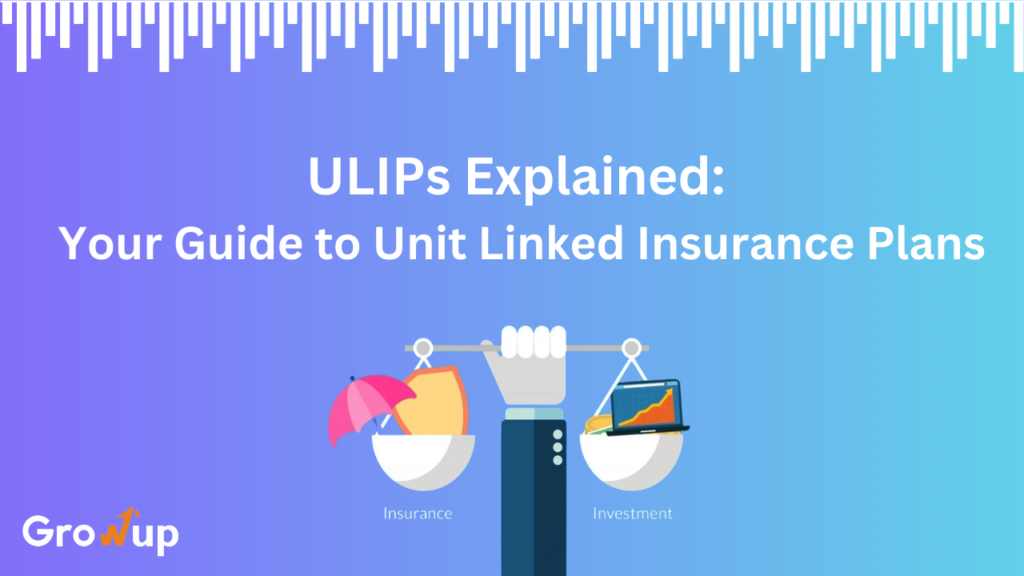ULIPs Explained: Your Guide to Unit Linked Insurance Plans

In today’s dynamic financial landscape, individuals are constantly seeking investment avenues that offer a balance between growth potential and life protection. Unit Linked Insurance Plans (ULIPs) have emerged as a popular choice, catering to this very need. But with a plethora of options and complexities surrounding ULIPs, making an informed decision can be daunting. This blog aims to be your one-stop guide, delving deep into the world of ULIPs and empowering you to navigate it confidently.
Table of Contents
What is a ULIP?
A ULIP is a unique financial instrument that combines life insurance coverage with investment opportunities. A portion of your premium goes towards a life insurance benefit for your loved ones in case of your unfortunate demise. The remaining portion is invested in market-linked funds, such as equity or debt funds, with the potential to grow your wealth over the long term.
How Does a ULIP Work?
Understanding the flow of funds within a ULIP is crucial. Here’s a breakdown:
- Premium Payment: You pay a regular premium amount to the insurance company.
- Allocation Charges: A small portion of the premium is deducted as allocation charges to cover the costs associated with managing the investment portion of the ULIP.
- Fund Allocation: The remaining premium (after allocation charges) is invested in your chosen fund(s). These funds can be equity-focused (potentially higher returns but with market volatility), debt-focused (lower risk, stable returns), or a balanced mix of both.
- Unit Purchase: The invested amount is used to purchase units in the chosen fund(s). The number of units you receive depends on the Net Asset Value (NAV) of the fund on that particular day. NAV reflects the market value of the underlying assets in the fund.
- Investment Growth: The value of your investment grows with the performance of the chosen funds. As the NAV of the units increases, so does the overall value of your ULIP.
- Maturity Benefit: Upon policy maturity, you receive the accumulated fund value (number of units multiplied by the current NAV) along with any accrued bonuses (if applicable) from the insurance company.
- Death Benefit: In case of the policyholder’s unfortunate demise during the policy term, the nominee receives the death benefit amount, which is typically the higher of the Sum Assured or the fund value at that time.
Key Features of ULIPs
- Life Cover and Investment: ULIPs provide life insurance protection while offering the potential for wealth creation through market-linked investments.
- Flexibility: ULIPs offer a range of investment options, allowing you to tailor your plan according to your risk appetite and financial goals. You can often switch between funds within the policy term to manage your risk exposure.
- Market-Linked Returns: ULIPs have the potential to generate higher returns compared to traditional insurance plans due to their investment component. However, returns are not guaranteed and are subject to market fluctuations.
- Policy Term: ULIPs come with a predetermined policy term, ranging from 10 to 30 years. You cannot withdraw your entire investment before the term ends (except in specific situations).
- Partial Withdrawals: Some ULIPs allow partial withdrawals after a lock-in period, offering some liquidity during the policy term.
- Premium Redirection: You can often redirect a portion of your future premiums towards premium waiver benefit riders, which pay your future premiums if you become disabled.
- Tax Benefits: ULIPs offer some tax advantages. Premiums paid towards ULIPs are eligible for tax deductions under Section 80C of the Income Tax Act (subject to limits). Additionally, the maturity benefit is generally tax-free if the policy is held for the minimum stipulated term (5 years in most cases).
Understanding Policy Charges
Understanding the various charges associated with ULIPs is essential:
- Allocation Charges: As mentioned earlier, a small fee is deducted from your premium to cover the costs of managing the investment portion of the ULIP.
- Policy Administration Charges: These charges cover the administrative costs associated with maintaining your ULIP.
- Mortality Charges: These charges go towards funding the life insurance component of the ULIP.
- Fund Management Charges: The fund management company levies a fee for managing the underlying assets in the chosen funds.
- Surrender Charges: If you withdraw your entire investment before the policy term ends, you may incur surrender charges. These charges are typically higher in the initial years of the policy.
To Be Continue ……….
Why Choose ULIPs for Investment?
ULIPs offer growth potential.
Benefits of ULIPs
Life protection with ULIPs.
Flexibility with ULIPs
Tailor your plan with ULIPs.
Tax Benefits of ULIPs
Tax deductions and benefits.
Why ULIPs?
About ULIPs
ULIPs are a popular choice among investors looking for growth potential and life protection. They invest in market-linked funds, such as equity or debt funds, which have the potential to generate higher returns compared to traditional investment options. A portion of your premium goes towards a life insurance benefit for your loved ones in case of your unfortunate demise. ULIPs offer a range of investment options, allowing you to tailor your plan according to your risk appetite and financial goals. You can often switch between funds within the policy term to manage your risk exposure. ULIPs offer tax advantages. Premiums paid towards ULIPs are eligible for tax deductions under Section 80C of the Income Tax Act (subject to limits). Additionally, the maturity benefit is generally tax-free if the policy is held for the minimum stipulated term (5 years in most cases). Investing in ULIPs can be an effective way to take control of your financial future. With the potential for high returns and life insurance coverage, ULIPs provide a unique combination of benefits.